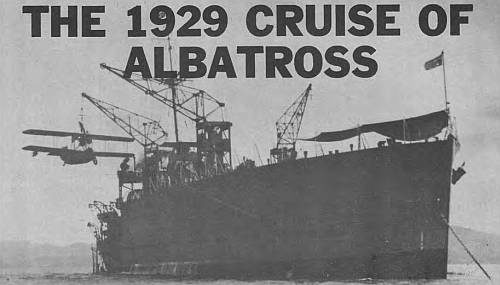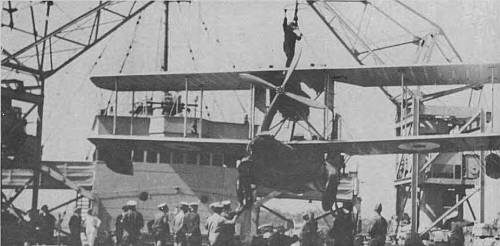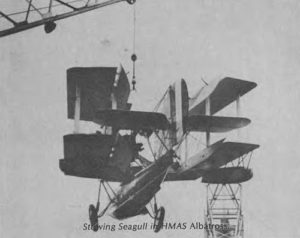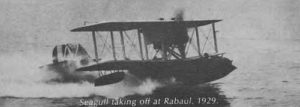- Author
- A.N. Other and NHSA Webmaster
- Subjects
- Ship histories and stories
- Tags
-
- RAN Ships
- HMAS Albatross, HMAS Canberra I, HMAS Australia II
- Publication
- September 1974 edition of the Naval Historical Review (all rights reserved)

The 1929 cruise of the seaplane carrier, HMAS Albatross, to New Guinea, New Ireland and New Britain was unique in that it was the first overseas demonstration of Australian naval air power. The cruise was in fact a vice regal visit to the Pacific outposts by Their Excellencies, the Governor-General, Lord Stonehaven, and Lady Stonehaven. Albatross and her aircraft made a profound impression on the natives of the area who flocked down from remote mountain villages in thousands. This article shows the highlights of the cruise.
THE NAVAL BOARD DECISION to use the seaplane carrier in preference to the two new eight-inch cruisers, Australia and Canberra, for the vice regal Pacific cruise was dictated by both economic restrictions and the need for the new carrier to carry out a long cruise with aircraft embarked. Lord and Lady Stonehaven boarded Albatross at Sydney on July 3 1929, and sailed north the same day.
Good sea conditions made the passage pleasant and visits were made to Brisbane, Dunk Island, Lizard Island and Thursday Island. Their Excellencies, Captain Feakes reported, enjoyed the voyage through the Inner Passage of the Barrier Reef and spent many hours on deck watching the islands and reefs at close range.
Port Moresby, the first port on the itinerary,was reached on July 10. A full programme of official and unofficial functions had been arranged by the Administration. The ship provided a guard of honour for the Governor-General. Ship’s officers were guests to the dinners and the official ball. The ship’s company was granted generous leave and were guests to a display of native dancing held at the Port Moresby racecourse.
Albatross responded by a cocktail party on board and a display of flying by the ship’s Seagull III flying boats. The latter excited the hordes of natives who crowded every vantage point and paddled out into the harbour in their canoes.
On the 14th Albatross visited Samarai during which the Governor-General paid a two-hour visit to the district officer’s residence. At this small port the seaplane carrier was surrounded by a fleet of native canoes loaded to the waterline with natives and goods for trade.

Next day the ship visited Salamau. When she was two hours from the port two of the flying boats were lowered into the sea and flew ahead as advance guard.

Salamau was followed by a two-day visit to Madang and Alexishaven. Kavieng on the northern tip of New Ireland was visited on the 22nd. During the two-day stay the crew visited nearby plantations and mission stations.
A full week was spent in Rabaul’s beautiful harbour. As this was the administrative centre Lord and Lady Stonehaven stayed at the official residence ashore.
The ship’s programme called for intensive flying operations and flights were made along the coast to nearby islands. Photographs taken during the exercises were later passed on to the RAN Hydrographer.

A special commemorative service was held on August 8, the fifteenth anniversary of the Royal Australian Navy’s attack on Rabaul in World War I. A detachment from the ship marched through the town’s streets and Lord Stonehaven made an inspired speech on the Empire’s dependence on the Navy.
The highlight of the visit was the illumination of Albatross.

At each port native police boys and tribal chiefs were invited aboard to inspect the marvels of a modern fighting ship. The natives called Albatross ‘the mother bird’ and her aircraft ‘the chickens’.
Newspapers of the period described the cruise as the most successful flag-showing cruise for many years and indeed it was.




